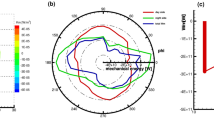Abstract
The numerical three-dimensional MHD model is used to study the formation of the magnetic barrier in the inner part of the magnetosheath near the magnetopause. The set of the quasistationary solutions for several characteristic directions of the interplanetary magnetic field (IMF) has been obtained: for northward and southward IMF, for the direction along the Parker helix (at an angle of 45° with respect to the Sun-Earth line), and for the predominantly radial direction (at an angle of 20° with respect to the Sun-Earth line). The mechanism used to take into account the effect of magnetic reconnection at the magnetopause on a flow in the magnetosheath is introduced in the case of southward IMF. The results of the calculations indicate that the magnetic field absolute value in the magnetic barrier reaches its maximal value when IMF is northward. The introduction of magnetic reconnection at southward IMF can result in an insignificant decrease in the field value. However, the model predicts that a decrease in the magnetic field is much more substantial when the IMF direction is close to radial.
Similar content being viewed by others
References
I. I. Alexeev and V. V. Kalegaev, “Structure of the Magnetic Field in the Magnetosheath of the Earth’s Magnetosphere,” Geomagn. Aeron. 41, 309–316 (2001) [Geomagn. Aeron. 41, 297–304 (2001)].
I. I. Alexeev, “The Magnetic Field Component Normal to the Magnetopause,” Geomagn. Aeron. 24, 16–21 (1984).
S. W. H. Cowley, “The Causes of Convection in the Earth’s Magnetosphere: A Review of Developments during the IMS,” Rev. Geophys. Space Phys. 20, 531–565 (1982).
N. U. Crooker, T. E. Eastman, and G. S. Stiles, “Observations of Plasma Depletion in the Magnetosheath at the Dayside Magnetopause,” J. Geophys. Res. 84, 869–874 (1979).
N. V. Erkaev, “Results of Studying the MHD Flow around the Magnetosphere,” Geomagn. Aeron. 28, 529–541 (1988).
N. V. Erkaev, “The Solar Wind Flow around the Earth’s Magnetosphere,” in Studies within the Scope of the International Projects, Ed. by M. I. Pudovkin and V. S. Semenov (Interdepartmental Geophysical Committee, Presidium of the USSR Academy of Sciences, Moscow, 1989) [in Russian].
G. A. Korn and T. M. Korn, Mathematical Handbook for Scientists and Engineers (McGraw-Hill, New York, 1968; Nauka, Moscow, 1973).
J. Merka, A. Szabo, J. Safrankova, and Z. Nemecek, “Earth’s Bow Shock and Magnetopause in the Case of a Field-Aligned Upstream Flow: Observation and Model Comparison,” J. Geophys. Res. 108 (2003).
M. I. Pudovkin and V. S. Semenov, “Reconnection Theory and Interaction between the Solar Wind and the Earth’s Magnetosphere,” in Studies within the Scope of the International Projects, Ed. by N. A. Tsyganenko (Nauka, Moscow, 1985) [in Russian].
M. I. Pudovkin and V. V. Lebedeva, “The Solar Wind Parameters in the Magnetosheath in the Model with the Magnetic Barrier,” Geomagn. Aeron. 27, 22–27 (1987).
M. I. Pudovkin, “Formation and Characteristics of the Magnetic Barrier before the Dayside Magnetopause,” Geomagn. Aeron. 27, 18–21 (1987).
M. I. Pudovkin, B. P. Besser, and S. A. Zaitseva, “Magnetopause Stand-off Distance in Dependence on the Magnetosheath and Solar Wind Parameters,” Ann. Geophys. 16, 388–396 (1998).
M. I. Pudovkin, M. F. Heyn, and V. V. Lebedeva, “Magnetosheath’s Parameters and Their Dependence on Intensity and Direction of the Solar Wind Magnetic Field,” J. Geophys. Res. 87, 8131–8138 (1982).
A. A. Samsonov and M. I. Pudovkin, “Flow of an Ideal Atmosphere CGL Plasma around a Sphere,” Geomagn. Aeron. 38(6), 50–57 (1998) [Geomagn. Aeron. 38, 727–731 (1998)].
J.-H. Shue, P. Song, C. T. Russell, et al., “Magnetopause Location under Extreme Solar Wind Conditions,” J. Geophys. Res. 103, 17 691–17 700 (1998).
G. L. Siscoe, N. U. Crooker, G. M. Erickson, et al., “MHD Properties of Magnetosheath Flow,” Planet. Space Sci. 50, 461–471 (2002).
J. R. Spreiter and S. S. Stahara, “Magnetohydrodynamic and Gasdynamic Theories for Planetary Bow Waves,” in Collisionless Shocks in the Heliosphere: Reviews of Current Research, Ed. by B. T. Tsurutani and R. G. Stone, (AGU, Washington, 1985) pp. 85–107.
J. R. Spreiter, A. L. Summers, and A. Y. Alksne, “Hydrodynamic Flow around the Magnetosphere,” Planet. Space Sci. 14, 223–253 (1966).
C. C. Wu, “MHD Flow Past an Obstacle: Large Scale Flow in the Magnetosheath,” Geophys. Res. Lett. 19, 87–90 (1992).
B. J. Zwan and R. A. Wolf, “Depletion of Solar Wind Plasma near a Planetary Boundary,” J. Geophys. Res. 81, 1636–1648 (1976).
Author information
Authors and Affiliations
Additional information
Original Russian Text © A.A. Samsonov, 2007, published in Geomagnetizm i Aeronomiya, 2007, Vol. 47, No. 3, pp. 336–345.
Rights and permissions
About this article
Cite this article
Samsonov, A.A. Specific features of magnetic barrier formation near the magnetopause. Geomagn. Aeron. 47, 316–324 (2007). https://doi.org/10.1134/S0016793207030061
Received:
Accepted:
Issue Date:
DOI: https://doi.org/10.1134/S0016793207030061




